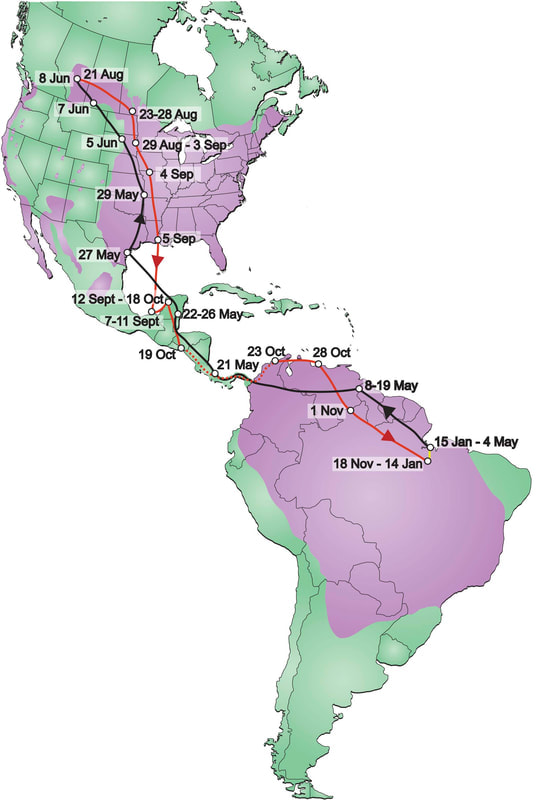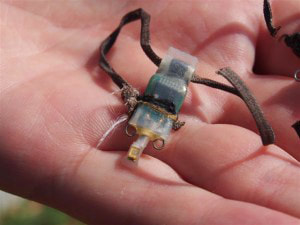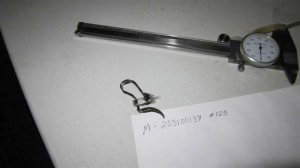“Purple Martins are fairly common birds, especially in the southeastern U.S., but their numbers decline by approximately 0.5% per year, resulting in a cumulative decline of about 25% between 1966 and 2019, according to the North American Breeding Bird Survey.
Humans have helped counteract declines somewhat by putting up nest boxes, and people now provide virtually all nest sites for Purple Martins in the eastern U.S. However, introduced species such as European Starlings and House Sparrows often take over martin houses and injure or kill eggs and nestlings. Purple Martins are also sensitive to cold snaps; bad weather kills more birds than all other sources of mortality combined.
Click here for more information from Purple Martin Conservation.
PURPLE MARTIN (PUMA) MIGRATION MAPS & PURPLE MARTIN GEOLOCATORS

Ellis Nature Centre is pleased to announce the release of another scientific paper related to the documentation of Purple Martin migration using GPS transmitters. Find out where one of our Alberta birds overwintered!
https://ellisnaturecentre.ca/wp-content/uploads/2024/04/puma_gps-tracking_paper_mar_2017.pdf
Purple Martin Geolocators:
Over the past few years, Ellis Bird Farm (EBF) has teamed up with Dr. Kevin Fraser (University of Manitoba) to track Purple Martins (Progne subis) using light-level geolocators. Dr. Fraser, trained under Dr. Bridget Stutchbury, with her team at York University (https://www.yorku.ca/science/lab/bstutch/) have pioneered the use of geolocators on both Wood Thrushes and Purple Martins. Geolocators, which record sunrise and sunset times and can thus determine latitude and longitude, enable researchers to reconstruct migration routes and wintering areas. This technology is revolutionizing the understanding of migration and how bird populations are connected in space and time.
Charlie and Winnie Ellis had Purple Martins nesting on the farm in the 1960s and 1970s. Numbers gradually declined as tree growth crowded the houses, then a severe spring storm in 1982 killed the last few remaining pairs. The martins returned in 1999 when new houses were put up by Ellis Bird Farm under the mentorship of a local martin organization, the Purple Martin Conservancy (PMC). Martin numbers have increased each year and the 70 pairs that now nest on the site are enjoyed by over 10,000 visitors each summer. Needless to say, we were keen to get involved with the geolocator project when given the invitation by the Camrose Wildlife and Stewardship Society. Our sites are of particular interest to researchers because these birds are breeding at the northern edge of their range.
In 2012, a total of 22 geolocators were deployed at EBF and 29 in the Camrose area. Under the guidance of PMC, our staff assisted with trapping and other logistics, and Dr. Fraser trained our team to quickly and gently attach the units. The deployments were watched by a fascinated public as well as several school groups. Several adults and many thrilled children were able to release the birds, newly outfitted with their tiny backpacks.
As soon as the martins began arriving back at Ellis Bird Farm in late April 2013, staff and volunteers-armed with spotting scopes and binoculars spent hours searching for returned birds. We also put the call out to all martin keepers in the area, asking them to watch for geo’d birds at their sites. With only the tiny probe visible, and then only when the feathers were in a certain position, the search was a challenge. Finally, on May 15th, we were able to confirm our first geo’d bird, a female. Using a very high tech capturing system (a long-handled paint roller!), we trapped the bird, lowered the house and gingerly removed her from her compartment. In the safety of an office, with the door closed perchance she escaped, we carefully snipped off her little pack and packaged it for shipping to Dr. Fraser. Within a few days, he had downloaded the data and, for the first time ever, was able to share with us the remarkable journey of the first northern nesting martin ever to be tracked. We named this bird Amelia in honour of the word’s most famous female aviator. Logging the longest journey of any martin ever recorded, Amelia left Ellis Bird Farm on August 24th, headed east, then turned south, crossed the Gulf of Mexico, spent 28 days in Belize and then spent the remainder of the winter in three different roosting sites in the Amazon Basin. What is most remarkable is her return to the farm: she left Brazil on April 24 and rocketed back to Ellis Bird Farm in only 21 days, averaging 375 mi (600 km) per day! The map Dr. Fraser prepared of her journey is shown here.
Over the next few weeks, six more geo’d birds were captured (five at Ellis Bird Farm and one in Camrose). Maps and travelogues were created for all units except one, which disappointingly had a dead battery. Summaries of these journeys can be found on this page.
In 2014, we re-trapped eight more birds and one – Marco Polo – returned with a geo on his back for two years in a row. The data provided by these returning birds is “gold” for researchers. By the end of the summer, we had deployed an additional 51 geolocators and 5 GPS units on our martins.
Not only is this project remarkable because it revealed new information, it has provided us with a wonderful opportunity to share the journeys with our visiting public and local media. It was amazing to see how engaged visitors were learning of these birds’ remarkable travels. In many years of teaching the public about nature, we have never witnessed visitors becoming so touched, in such a transformative way, upon hearing the real-life stories of “our” birds.
In 2014, Dr. Fraser and EBF made science history by being the first to deploy geolocators on Mountain Bluebirds (Sialia currucoides). A total of 31 birds were outfitted with geolocators so we hope that, in the spring, we will be privy to their migration routes between their breeding grounds in Central Alberta and their overwintering areas in the southern US and northern Mexico.
Mountain Bluebirds are a much-loved species. In Alberta, as elsewhere across North America, dedicated organizations and many individuals have established nestbox trails in an attempt to bolster the bluebird populations. Educational efforts by Ellis Bird Farm and other bluebird organizations in Alberta have served to increase public awareness about bluebirds and encourage participation in their conservation through the establishment of nestbox trails.
Despite valiant conservation efforts, however, Mountain Bluebird populations are showing significant regional declines. The bluebird population has declined by 75% in the Ellis Bird Farm Management Area (a one hundred square mile area surrounding the farm) since a population high was recorded in the early 1990s. While spring weather, especially a devastating snowstorm in the spring of 2008, has no doubt had an impact on Alberta populations, there may be other factors contributing to this alarming trend. These factors may occur within Alberta, along migratory routes and/or in their wintering range.
Although extensive data have been collected on Mountain Bluebird productivity on most major bluebird trails in the province, significant data deficiencies remain. For example, post-fledgling movements of Alberta Mountain Bluebirds are unknown, and migratory routes and overwintering routes are known only from a few banding records. It is hoped that the use of these technologies will help identify specific post-fledging movements, migratory routes, stopovers and year-round habitat. Ideally, this information will lead to a better understanding of the threats and perhaps assist with mitigation measures.
Bluebirds can be considered the proverbial ‘canaries in the coal mine’ of ecosystem health. By linking Alberta breeding populations to their overwintering sites in the southern US and northern Mexico, we can examine impacts not only of local factors on Alberta’s environment, but also those outside of Alberta’s borders.
Funding support for this important project has been provided by Ellis Bird Farm, the Red Deer and District Community Foundation, TD Friends of the Environment, North American Bluebird Society, Sherry and Marion Linn, Bird Studies Canada (James L Baillie Memorial Fund), the Alberta Sport Recreation Parks and Wildlife Foundation and Dow Canada. The funds provided have been critical to the success of this very important research project.
HISTORICAL ENTRY FROM BLOG POSTED ON MAY 28, 2013
First Tracked Purple Martin in Alberta!
Ellis Bird Farm is pleased to announce that data has been summarized from the first Purple Martin in Alberta to be tracked using light level geolocators. This first bird, a two-year old female, was banded as a nestling at Ellis Bird Farm in 2011. A geolocator was attached on June 13, 2012 and she was recaptured on May 15, 2013. The geolocator was sent to Dr Kevin Fraser of York University, who analyzed the data and provided the following information:
This bird had a very interesting migration and I was in awe as I was analyzing the data. Firstly, she traveled 21,000 km over spring and fall migration!! This is the longest migration distance that we have tracked for a martin so far – the average annual distance for previously tracked birds is ~14 000 km. Alberta martins breed further north than other birds we’ve tracked, so we expected them to have a longer migration distance. But we didn’t know just how far because we didn’t know where their wintering sites were.
Speaking of wintering sites, this bird had three different wintering roosts in the state of Para, Brazil. She did not overwinter in the heart of the Amazon where we have found some of the other eastern martins, but areas further east where there is more agricultural development. Later in the winter, she roosted near to the Atlantic coast. This is also where she began her spring journey, making her spring migration distance very long (~10 200 km). If you add the distance traveled between wintering roosts, this bird logged an impressive 22 300 km over the course of the year.
For spring migration, she left what seems quite late on Apr 25 but rocketed all the way back to Ellis Bird Farm in just 21 days! Her average flight speed was 600 km a day. She made a 4 day stop near the tip of the Yucatan Peninsula before making a direct crossing of the gulf.
She also crossed the gulf on fall migration. Her fall migration was much longer, totaling 75 days. Contributing to this longer duration was a 28 day stop in Belize. Some other martins have similar long stops in this region and through our analysis of feather samples, we’ll be able to figure out if this is an important area for moult.
Alberta purple martin geolocator research is a cooperative project between York University, Camrose Wildlife Stewardship Society, the Purple Martin Conservancy and Ellis Bird Farm. Funding support for the 2012 Ellis Bird Farm component of the project was provided by the Red Deer and District Community Foundation. Funding for the 2013 project is being provided by the Red Deer and District Community Foundation and the Alberta Sport Recreation, Parks and Wildlife Foundation.
UPDATE** Dr. Kevin Fraser was interviewed on CBC’s Homestretch on June 6th.




























